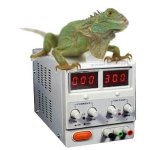The Mighty Volt said:Is it fair to say that smaller battery packs, say 24v 10Ah, with therefore fewer cells, are easier to keep balanced, and therefore harder to pull out of balance, than larger packs using more individual cells?
I would think so, but only because there are fewer cells to go wrong. If the chance of a cell going out of balance is say 5%, a 4S pack has a 20% chance of going out of balance (1.05^4). A 12S pack would have an 80% chance (1.05^12).
And the series count is more important than the parallel count. Paralleled cells tend to average their charge balance.



